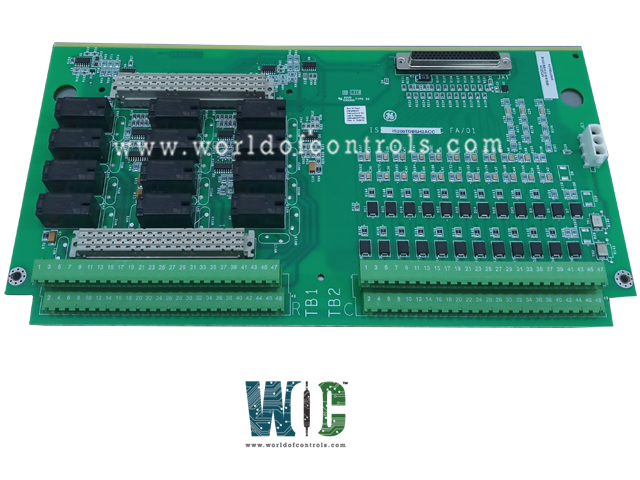SPECIFICATIONS
Part No.: IS200TDBSH2ABC
Manufacturer: General Electric
Country of Manufacture: United States of America (USA)
Max response time on: 25 ms typical
Max response time off: 25 ms typical
Contact material: Silver cad-oxide
Temperature Operating: -30 to 65oC
Product Type: Contact Input Terminal Board
Availability: In Stock
Series: Mark VIe
Functional Description
IS200TDBSH2ABC is a contact input terminal board developed by GE. It is a part of the Mark VIe control system. The board serves as a simplex contact input/output terminal board, facilitating easy integration into various systems. The board is engineered to accommodate a maximum current rating of 5 A and provides ample voltage clearance suitable for 250 V AC across all customer screw and JW1 circuits. It's worth noting that the relay rating serves as the determining factor for each specific application.
Features
- Mounting Options: The board is designed for flexible mounting options, including DIN-rail or flat mounting, providing versatility in installation configurations.
- Contact Inputs: This board accommodates 24 group-isolated contact inputs, which are compatible with nominal voltages of 24, 48, or 125 V DC wetting voltage from an external power source. These inputs are equipped with noise suppression circuitry, offering protection against surge and high-frequency noise for reliable operation.
- Relay Outputs: The board boasts 12 form-C relay outputs, enhancing its functionality in controlling various processes and systems. Additionally, the board supports the integration of different option cards to expand the capabilities of the relay outputs, enabling customization according to specific requirements.
Contact Inputs
- Functionality and Signal Conditioning: The contact input functionality and on-board signal conditioning mirror those of the board. However, they are specifically scaled to accommodate wetting voltages of 24, 48, and 125 V DC. The input wetting voltage range varies accordingly: 16 to 32 V DC, 32 to 64 V DC, and 100 to 145 V DC, respectively. The threshold voltage for contact sensing is set at 50% of the wetting voltage.
- Current Limitation and Protection: Contact input currents are effectively managed to ensure operational safety and reliability. The first 21 circuits are resistance-limited to 2.5 mA, while circuits 22 through 24 can handle currents up to 10 mA. Additionally, the 24 V DC supply on the TDBSH2 terminal is safeguarded by polymer positive temperature coefficient fuses, which limit the current to 0.5 A. These fuses are resettable, enhancing the board's protection against overcurrent situations.
- Noise Suppression and Surge Protection: Each input is equipped with filters that effectively mitigate high-frequency noise and suppress surge near the point of signal entry. This ensures that the signals remain clean and stable, even in challenging industrial environments with high levels of electromagnetic interference (EMI) and transient events.
- Signal Processing and Transfer: The discrete input voltage signals are routed to the I/O processor, where they pass through optical isolators for isolation purposes. Subsequently, the signals are converted to digital format and transferred to the controller for further processing and action.
Configuration
- No Jumpers or Hardware Settings: The TDBS terminal board does not feature any jumpers or hardware settings for configuration. Instead, configuration adjustments are managed through other means.
- Option Board WROBH1: Jumper Configuration for Relay Power: WROBH1 includes six jumpers that control the application or removal of power from a relay. Initially, all six jumpers are installed on the board. To use a relay solely for dry contacts without power distribution, the corresponding jumper is removed.
- Option Board WROFH1: Fuse Configuration: WROFH1 does not feature any jumpers. The inclusion or exclusion of a series fuse for each relay is determined by the terminal point designated as the relay common. Removing the associated WROF fuse allows direct utilization of the fuse voltage sensing circuit as a voltage detector.
- Option Board WROGH1: Fuse Configuration: Similar to WROFH1, WROGH1 does not have jumpers associated with it. Each relay's corresponding fuse may be removed if the relay is intended to provide dry contacts without power.
The WOC team is always available to help you with your Mark VIe requirements. For more information, please contact WOC.
Frequently Asked Questions
What is IS200TDBSH2ABC?
It is a contact input terminal board developed by GE under the Mark VIe series.
What configuration options are available for the board?
The terminal board does not feature any jumpers or hardware settings for configuration. Instead, adjustments are made through other means.
How does the WROBH1 option board handle relay power distribution?
WROBH1 includes six jumpers that control the application or removal of power from a relay. Users can remove the jumper associated with a relay to use it solely for dry contacts without power distribution.
What is the configuration process for option board WROFH1?
WROFH1 does not have jumpers. The inclusion or exclusion of a series fuse for each relay is determined by the terminal point designated as the relay common. Removing the associated WROF fuse allows direct utilization of the fuse voltage sensing circuit as a voltage detector.
How does option board WROGH1 handle relay fuses?
Similar to WROFH1, WROGH1 does not feature jumpers. Users can remove each relay's corresponding fuse if the relay is intended to provide dry contacts without power.
Are there any hardware adjustments required for the WROFH1 and WROGH1 boards?
No hardware adjustments are necessary for these boards. Users can configure the relay fuses as needed without the use of jumpers.
